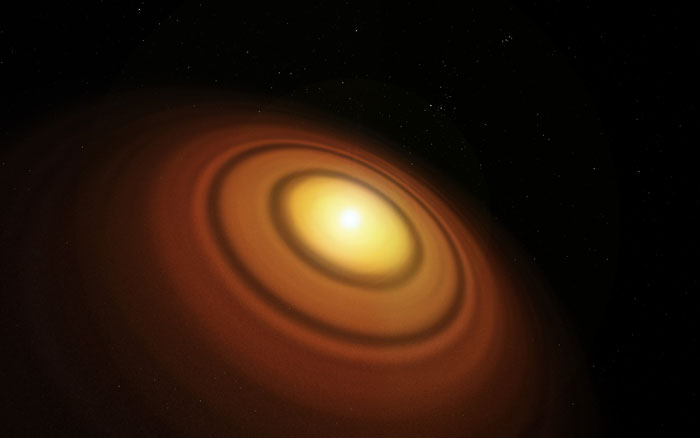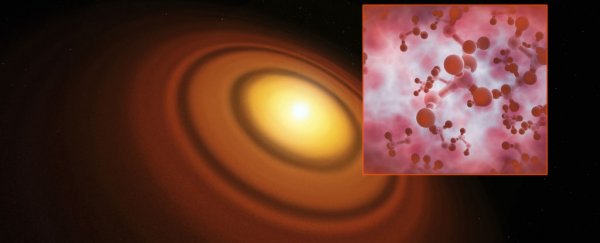If you were to wind the clock back, say, 4 billion years or so, our Solar System would look a little bit like this protoplanetary disc surrounding the baby star TW Hydrae.
This is the closest planet-forming disc of its kind that we know about, and now, scientists have discovered something floating within the gas that could be essential to life: the organic molecule methyl alcohol (methanol). This is the first time this compound has been found in a protoplanetary disc.
An international team of researchers detected the fingerprint of this gaseous methanol located some 170 light-years away by using the Atacama Large Millimeter/Submillimeter Array (ALMA) in Chile, an array of radio telescopes specifically designed to study light emissions from some of the coldest objects in the Universe.
That capability is what enabled the team to identify methanol around TW Hydrae, as the compound forms solely in the ice phase via surface reactions. In this case, the methanol was detected on minuscule dust grains that make up the protoplanetary disc. The researchers think it's released from the grains in its gaseous form.
"Finding methanol in a protoplanetary disc shows the unique capability of ALMA to probe the complex organic ice reservoir in discs and so, for the first time, allows us to look back in time to the origin of chemical complexity in a planet nursery around a young Sun-like star," said astronomer Catherine Walsh from the Leiden Observatory in the Netherlands.
Because methanol is an essential building block for other compounds that make up organic life, such as amino acids, finding it in a protoplanetary disk is a major discovery – as it could help us to learn about how organic molecules and maybe even life itself end up finding a home on the planets that emerge from these cosmic nurseries.
"Methanol in gaseous form in the disc is an unambiguous indicator of rich organic chemical processes at an early stage of star and planet formation," said one of the team, Ryan A. Loomis. "This result has an impact on our understanding of how organic matter accumulates in very young planetary systems."
Methyl alcohol isn't the kind of alcohol most of us are familiar with, although strangely enough the drinkable sort, ethyl alcohol, is also found in space. Neither of which should be confused with space whiskey, either.
In addition to detecting methanol, the team found that the distribution of the gas within the disc creates a ring-like pattern in the cloud of matter (which you can see in the images on this page). The scientists hypothesise that this ring is formed when larger dust grains in the icy mass decouple from the gas, and begin to drift inward to TW Hydrae, thanks to the star's gravitational pull.
The methanol discovery follows fast on the heels of another important molecular find in space, with researchers this week announcing the first detection of chiral molecules in interstellar space – a key property of the organic molecules that make up all the living things on Earth.
 Artist's impression of the protoplanetary disc surrounding the young star TW Hydrae. Credit: ESO/M. Kornmesser
Artist's impression of the protoplanetary disc surrounding the young star TW Hydrae. Credit: ESO/M. Kornmesser
While neither of these findings are obviously on the level of actually finding alien life itself, they're the next best thing, adding weight to the case that life's building blocks exist outside our Solar System – and demonstrating the epic reach of today's best telescopes.
"The successful detection of cold gas-phase methanol in a protoplanetary disk implies that the products of ice chemistry can be explored in disks," the authors write in their paper, "opening a window into studying complex organic chemistry during planetary system formation."
The findings have been reported in The Astrophysical Journal Letters.
